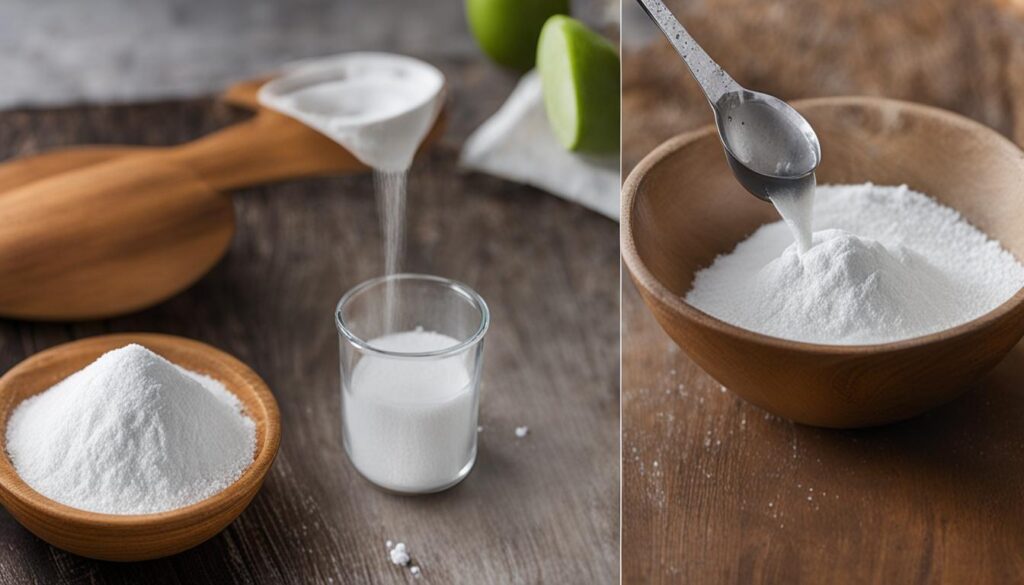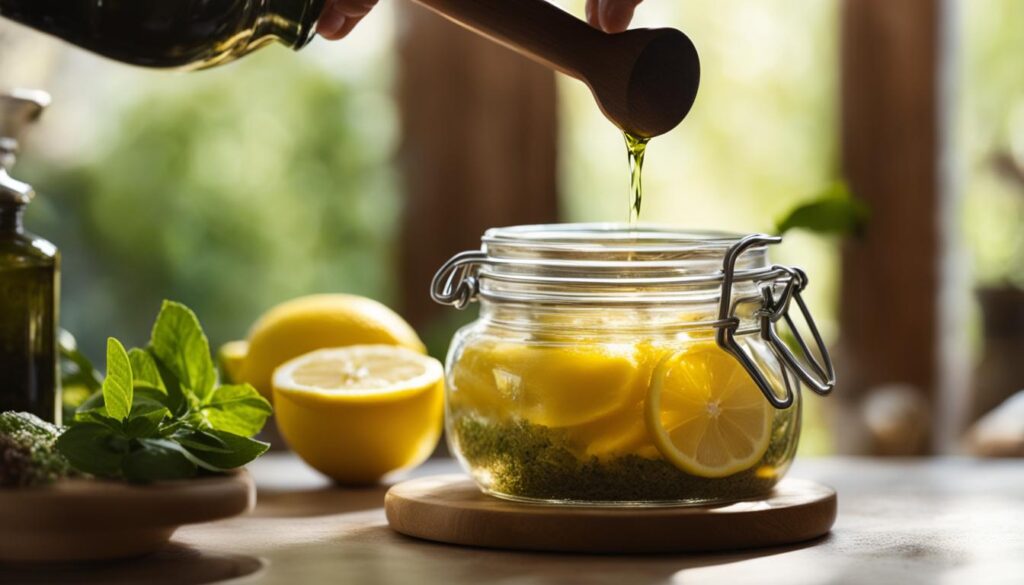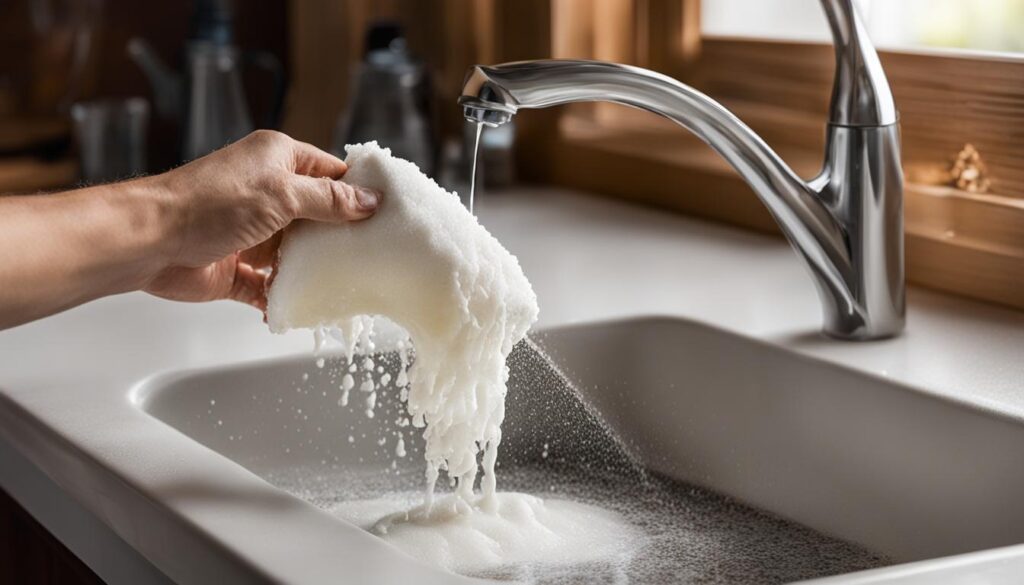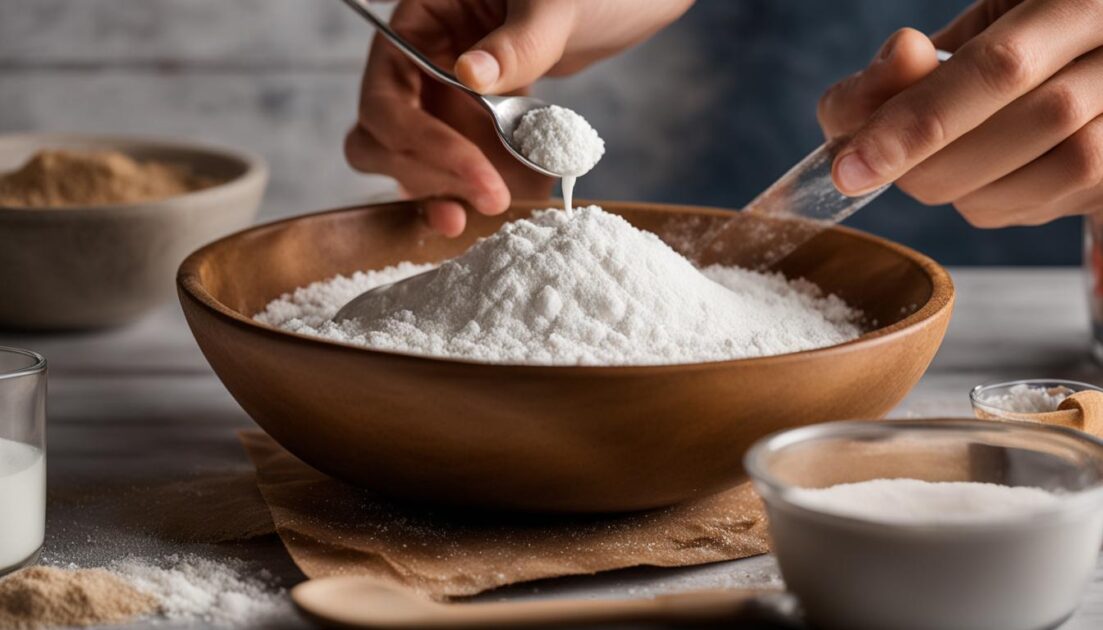Are you in the middle of baking and realize you’re out of baking soda? Don’t worry, you can easily make your own at home. Baking soda is an essential ingredient in many recipes, and knowing how to make it yourself can save you a trip to the store. In this guide, I’ll show you a simple DIY recipe for homemade baking soda.
To make a batch of homemade baking soda, you’ll need two common ingredients: baking soda and cream of tartar. These ingredients are readily available in most kitchens and grocery stores, making the process quick and convenient.
Now, you may be wondering why we need cream of tartar. Baking soda requires an acid to activate its leavening properties. Cream of tartar acts as that acid and helps the baking soda produce the desired rise in baked goods.
Follow the step-by-step guide below to make your own baking soda:
Key Takeaways:
- Gather the ingredients: 1 tablespoon of baking soda and 2 tablespoons of cream of tartar.
- Mix the baking soda and cream of tartar together in a bowl.
- Stir the mixture until well combined.
- Store the homemade baking soda in an airtight container for future use.
- Remember to adjust the amount of homemade baking soda in your recipes by using a 4:1 ratio (4 teaspoons of homemade baking soda for every 1 teaspoon of regular baking soda).
The Benefits of Making Your Own Baking Soda
Making your own baking soda has several benefits. First, it’s a cost-effective alternative to buying commercially produced baking soda. Second, you have control over the ingredients, ensuring that it is pure and free from any additives or chemicals. Finally, making your own baking soda allows you to reduce waste and be more environmentally friendly. The process of making baking soda involves mixing baking soda with cream of tartar, which can easily be found in most grocery stores.
If you’re wondering why you should bother making your own baking soda when it’s readily available on store shelves, let me explain. By making your own baking soda, you not only save money but also have the freedom to choose high-quality ingredients. Commercially produced baking soda often contains additives like anti-caking agents, which may not be ideal for some recipes. By making your own, you can ensure that your baking soda is pure and free from any unwanted extras.
“I love making my own baking soda because it allows me to control the quality and purity of the ingredient. Plus, it’s a great way to reduce waste and be more environmentally conscious.” – Sarah, home baker
Furthermore, making your own baking soda is a simple process that requires just two ingredients: baking soda and cream of tartar. Cream of tartar is a natural acid that activates the baking soda, making it an essential component of the homemade baking soda recipe. Rest assured, cream of tartar is readily available in most grocery stores, ensuring that you can easily find the ingredients needed for making your own baking soda.
Economic and Environmental Advantages
Making your own baking soda brings economic advantages. It’s a cost-effective alternative to repeatedly purchasing commercially produced baking soda. By opting for the homemade version, you’ll save money in the long run without compromising on quality.
Additionally, creating your own baking soda promotes environmental sustainability. By reducing your reliance on packaged baking soda, you contribute to the reduction of plastic waste. Making baking soda at home allows you to use and reuse your own containers, minimizing the environmental impact associated with single-use packaging.
If you’re ready to give it a try, follow our step-by-step guide in the next section to learn how to make baking soda in the comfort of your own kitchen.
| Benefits of Making Your Own Baking Soda |
|---|
| Cost-effective alternative |
| Control over ingredients |
| Reduces waste |
| Economically advantageous |
| Environmentally sustainable |
Step-by-Step Guide to Making Baking Soda at Home
Here is a step-by-step guide on how to make baking soda at home:
- Gather the ingredients: 1 tablespoon of baking soda and 2 tablespoons of cream of tartar.
- Mix the baking soda and cream of tartar together in a bowl.
- Stir the mixture until well combined.
- Store the homemade baking soda in an airtight container.

Making your own baking soda at home is a simple and rewarding process. By following these easy steps, you can create your own baking soda that is free from additives or chemicals. Plus, it’s a cost-effective alternative to buying commercially produced baking soda. Store it in an airtight container to keep it fresh and ready for your next baking adventure or household cleaning task.
Tips for Using Homemade Baking Soda
When it comes to using your homemade baking soda in recipes, there are a few tips to keep in mind. Understanding the proper ratio and baking techniques will help you achieve the best results.
1. Ratio: When substituting homemade baking soda for regular baking soda, the ratio is important. For every 1 teaspoon of baking soda called for in a recipe, substitute it with 4 teaspoons of homemade baking soda. This ensures the proper rising and leavening of your baked goods.
2. Immediate Baking: Unlike commercial baking soda, homemade baking soda is not double-acting. It requires immediate baking after adding it to your batter or dough. This ensures that the leavening agent is activated and properly incorporated into your recipe.
“Proper understanding of the ratio and immediate baking are key to successfully using homemade baking soda in your recipes.”
By following these tips, you can confidently use your homemade baking soda in any recipe that calls for baking soda. Now, let’s move on to explore other unique uses for baking soda in the next section.

Other Uses for Baking Soda
Baking soda is not just for baking. It has a wide range of other uses, making it a versatile and essential ingredient in any household. Let’s explore some of its amazing uses:
Baking Soda for Cleaning
Baking soda is a gentle and effective cleaner that can be used on various surfaces. Here are some examples:
- Sinks: Sprinkle baking soda on a damp sponge or cloth and scrub away stains and odors.
- Tubs and Tiles: Create a paste by mixing baking soda with water and use it to clean bathroom fixtures and tiles.
- Microwaves: Place a bowl of water with a few tablespoons of baking soda inside the microwave and heat it for a few minutes. The steam will help loosen dirt and grime, making it easier to clean.
Baking Soda for Deodorizing
Baking soda is also excellent for neutralizing odors around the house. Here are some areas where it can be used as a deodorizer:
- Cutting Boards: Sprinkle baking soda on a damp cloth and wipe down cutting boards to eliminate strong odors.
- Dishwashers: Add a cup of baking soda to the dishwasher before running a cycle to remove food smells and freshen the appliance.
- Fridges and Freezers: Place an open box of baking soda in the refrigerator or freezer to absorb unpleasant odors.
Baking Soda for Emergencies
Did you know that baking soda can even help in emergency situations? Here’s why it’s a handy tool to have:
- Extinguishing Grease Fires: In case of a small grease fire in the kitchen, baking soda can be used to smother the flames. Do NOT use water, as it can spread the fire.
- Extinguishing Electrical Fires: Baking soda can also be used to put out small electrical fires by cutting off the oxygen supply. Remember to turn off the power source before attempting to extinguish the fire.
With its versatile uses, baking soda proves to be an indispensable household item that goes beyond baking.

Conclusion
Making your own baking soda at home is a practical and cost-effective alternative to purchasing commercially produced baking soda. By creating your own homemade baking soda, you have the advantage of controlling the ingredients and minimizing waste. This simple DIY method empowers you to tailor your baking essentials to your specific needs.
Beyond its traditional role in baking, baking soda offers a multitude of benefits and versatile applications. It can be utilized as a natural cleaning agent, aiding in the maintenance of spotless surfaces throughout your home. Additionally, baking soda serves as an effective deodorizer, neutralizing unwanted odors in various areas such as cutting boards, dishwashers, and refrigerators. Its ability to extinguish grease and electrical fires also makes it a valuable household essential.
Embracing the practice of making your own baking soda can bring numerous advantages to your life. Not only does it provide control, cost savings, and environmental benefits, but it also expands your arsenal of homemade alternatives. Incorporating homemade baking soda into your daily routine allows you to achieve desirable results while promoting a healthier lifestyle.
FAQ
What is the process of making baking soda at home?
The process of making baking soda at home involves mixing 1 tablespoon of baking soda with 2 tablespoons of cream of tartar. Stir the mixture until well combined and store it in an airtight container.
Why would I want to make my own baking soda?
Making your own baking soda at home has several benefits. It is a cost-effective alternative to buying commercially produced baking soda. It allows you to have control over the ingredients and ensures the purity of the product. Additionally, making your own baking soda reduces waste and is more environmentally friendly.
How much homemade baking soda should I use in a recipe?
When using homemade baking soda in a recipe, the ratio is 4 teaspoons of homemade baking soda for every 1 teaspoon of regular baking soda called for in the recipe.
Can homemade baking soda be used immediately after mixing?
Yes, homemade baking soda can be used immediately after mixing it into your batter or dough. Unlike commercial baking soda, homemade baking soda is not double-acting, so it should be baked right away.
What are some other uses for baking soda?
Baking soda has various uses beyond baking. It can be used as a gentle and effective cleaner for surfaces such as sinks, tubs, and tiles. It also works well as a deodorizer for cutting boards, dishwashers, fridges, and freezers. Additionally, baking soda can extinguish grease and electrical fires, making it a handy emergency tool.






